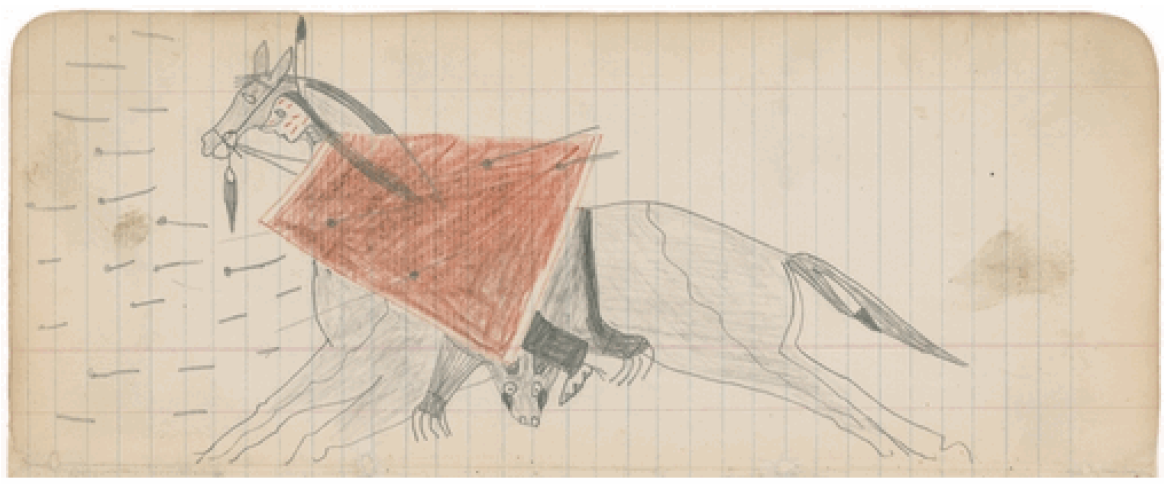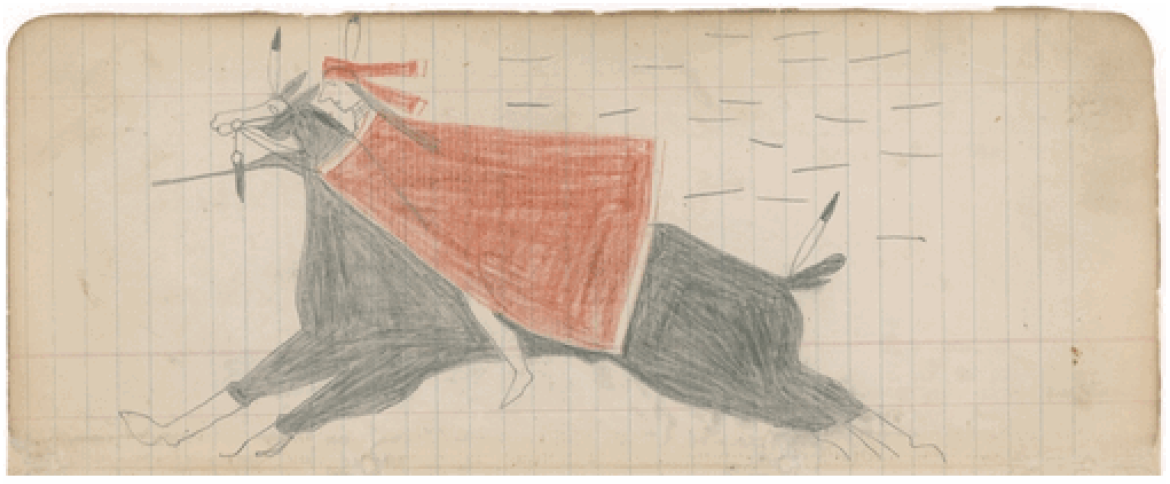|
|
Post by nicolas (carlo) on Dec 1, 2015 14:50:23 GMT -5
Great pictographs again, Graham. The last image is a perfect example of the red cape-turban combination.
|
|
|
|
Post by grahamew on Dec 1, 2015 15:58:45 GMT -5
Toh-Ki-e- to (a Yankton chief) by Catlin:  Could it be? |
|
|
|
Post by nicolas (carlo) on Dec 1, 2015 16:08:53 GMT -5
Certainly looks like it.
You're on a roll, Grahame.
|
|
|
|
Post by kingsleybray on Dec 1, 2015 16:41:11 GMT -5
digitallibrary.amnh.org/handle/2246/147Link to Clark Wissler's classic monograph on Oglala societies and ceremonial associations. A must read. Check pages 95-95 on 'The Horse Cult', the association of those who Dreamed of Horses or Sunkwakan wacipi (Horse Dance). Wissler writes on p. 96: "There was no special regalia, except that they usually used a piece of flannel on the head." Doesn't specify the colour, but my guess would be red. Don't know if it's the clue you need.I can't think of any other reference like that, a cloth headband or turban with a society connection. In the 1860s-70s Old Man Afraid of His Horses was the leader of the Horse Dance among the Oglala. In Lakota terms he was extraordinarily wealthy in horses, owning 100 head. The new SIRIS ledger image of the warrior with the red cloth turban and cape: given the evident Cheyenne River (Miniconjou etc.) connection -- wonder if he's High Backbone -- depicted like that by Amos Bad Heart Bull.
|
|
|
|
Post by lgarcia on Dec 1, 2015 17:47:39 GMT -5
I am looking at the painting of the Yankton by Catlin.
I am not looking at the red cloth headband, but the white buffalo (?) hide headpiece.
I believe there was a discussion about a different painting showing what I think they called it a cone-head headdress for want of a better term.
This was on the Plains Indian Material Culture website.
Anyone remember this discussion?
LouieG
|
|
|
|
Post by grahamew on Dec 2, 2015 2:08:14 GMT -5
|
|
|
|
Post by grahamew on Dec 2, 2015 7:07:47 GMT -5
Here's a better one - again by Catlin: A'h-sha-la-cóots-ah (Mole in the Forehead), Republican Pawnee:  |
|
|
|
Post by grahamew on Dec 26, 2015 9:40:48 GMT -5
For Christmas, I was lucky enough to get a copy of the catalogue for The Plains Indians: Artists of the Earth and Sky and one of the exhibits is a winter count held by the Nelson-Atkins Museum in Kansas City. It was collected by Dr John Wilz Napier Hudson sometime early in the 1900s and is credited to a Sicangu artist. Unfortunately, some of the events have been clipped because of the way it’s been printed, but here’s a full version from the internet:  If I’m reading this correctly (and I think I am, counting backward from the depiction of Crazy Horse's murder near the bottom left, but upside down as it's presented here - and following it round a little further up and along to the right, you'll see Crow Dog in civilised garb, as he was said to wear at the time, shooting Spotted Tail), the entry for 1870 (though numbered 47) is this:  Here we have another drawing of a man in a red stroud cape and headgear. Notice the high-backed animal (a wolf or fox?) glyph. Tempted to think this relates to the death of High Backbone, but his name refers to a buffalo (doesn't it?) and is drawn as such in the American Horse Winter Count (interestingly, he’s clad in a red blanket (but no headgear) in the Cloud Shield and Battiste Good counts). Unfortunately, having gone through the counts in Candace Greene’s The Year the Star’s Fell, James Howard’s Dakota Winter Counts as a Source of Plains History, the Kills Two count, those in Walker/DeMallie’s Lakota Society, the White Bull count, those at wintercounts.si.edu/flashindex.html and the Colhoff count, there seems to be no reference to the death of a man called anything vaguely resembling High Wolf or High-Backed Wolf for either this year or those immediately adjacent. Interestingly, the Colhoff and No Ears counts make reference to a man called Buffalo Hump being ‘lost’ (i.e. presumed killed by the enemy) the year after they mention High Backbone was killed. Still, food for thought and another representation of the cap/cape combination amongst the Lakota. |
|
|
|
Post by dT on Jan 1, 2016 23:03:14 GMT -5
grahamnew - excellent work. thanks for sharing. you are better at reading these Winter Counts than me. Maybe it helps to have a really clear picture.
definitely red was symbolic of war, and maybe honorable death. I am very surprised that traditional Lakotas have not answered this thread. I'll bet you that there are Lakotas who know a lot about this tradition. But probably they are not speaking here. Maybe they would tell you in private. Best Wishes.
|
|
eric
New Member

Posts: 31 
|
Post by eric on Aug 30, 2016 5:06:32 GMT -5
An influence/tradition from the Cheyennes ? Based on the 1783 entry in Makula's winter count: "A man with a red blanket was killed in a battle, a Cheyenne." This entry implies that the red blankets/capes have a relatively long tradition. Lowie states that the Wahpeton and Wahpekute "owl feather headress society" call the Sash (like that of the Miwatani) "Sina sa" = "Red blanket". So,the man Killed, may still be a warrior with a stake-down sash, depending on the interpretation of the word/pictograph. Eric |
|
eric
New Member

Posts: 31 
|
Post by eric on Aug 30, 2016 6:13:44 GMT -5
Grahamew,
Do you think it could be a sash, like that of Cheyenne Hota Mita Niyu or Sioux Miwatani society, with the lower part of it disappearing behind the horses right flank? Most likely he would have tucked the tip in his belt on the right side, so it would not bother his horse, or get caught somhow. It would also explain the eagle feather(s) hanging from it, below his left shoulder.
On the other hand, if you blow up the picture, it sort of looks like there som kind of bulge,next to his armpit, which could mean it is simply some charme tied in a big piece of trade cloth, ornamented with a couple of feathers and hung from a cloth strip or strap of an ammunition pouch.
Sorry, I reacted before I read the rest of the thread, and the theory with the pipe bundle makes a lot of sense.
Eric
|
|
|
|
Post by Dietmar on Feb 10, 2017 10:57:58 GMT -5
Eric has asked me to post this message referring to Carlo´s original question that started the thread: Concerning Red war capes, they often seem to go together with a red cloth headband.  Sweet Medicine part one page 337. Sweet Medicine part one page 337.
Suddenly a white horse and rider appeared, charging through the rain clouds. The Maiyun was riding bareback, and an offering cloth was tied arund his head. The rider was thunder himself.The custom of making cloth offerings is quite known to many plains tribes, there is mention of these being used in a ritual manner, the are loaded with power because they belong to a sacred object or being. It is not illogical that the sacred power could, to some extent, be transfered to the offering cloth an dgive the wearer power over the enemy or invisibility. Therefor these cloth capes and cloth headbands may be offerings to for instance is'siwun or other sacred objects or entities (depending on the people) used to protect warriors, and therefore protecting the people. Like Is'siwun or the turner can make the people invisible an give them strength, so can the loaded offering cloths make single warriors powerfull or invisible to help them to protect the people and the sacred objects they have in their custody. Eric |
|
|
|
Post by grahamew on Feb 13, 2017 13:17:55 GMT -5
That's great. We know war capes made from animal skins existed and we know they - and cloth capes - were sometimes painted with protective designs, but in Lakota ledger/skin drawings, we see the red cape often - and we see capes worn by members of other tribes (although there are times I think they may be simply blankets worn over the shoulders) but the red cap and cape combo seems rare. As far as I recall, I haven't seen it described anywhere, except in reference to Indian drawings. Sandoz, for example, describes events involving High Backbone but makes no reference to his dress, whereas she does with other Indians - and, yep, I realise she applies considerable dramatic licence and you wouldn't regard her work as pure history, but she did talk to people who knew him and the outfit he is depicted as wearing by Bad Heart Bull is, I would have thought, striking enough for comment. I do wonder, in the Lakota examples above, how many of the drawings represent the same individual...
|
|
|
|
Post by grahamew on Apr 13, 2017 11:38:26 GMT -5
|
|
|
|
Post by nicolas (carlo) on Jul 7, 2017 2:41:12 GMT -5
Two more excellent examples from His Fight / Jaw's ledger book (1884). One with and one without red turban / headband.   |
|